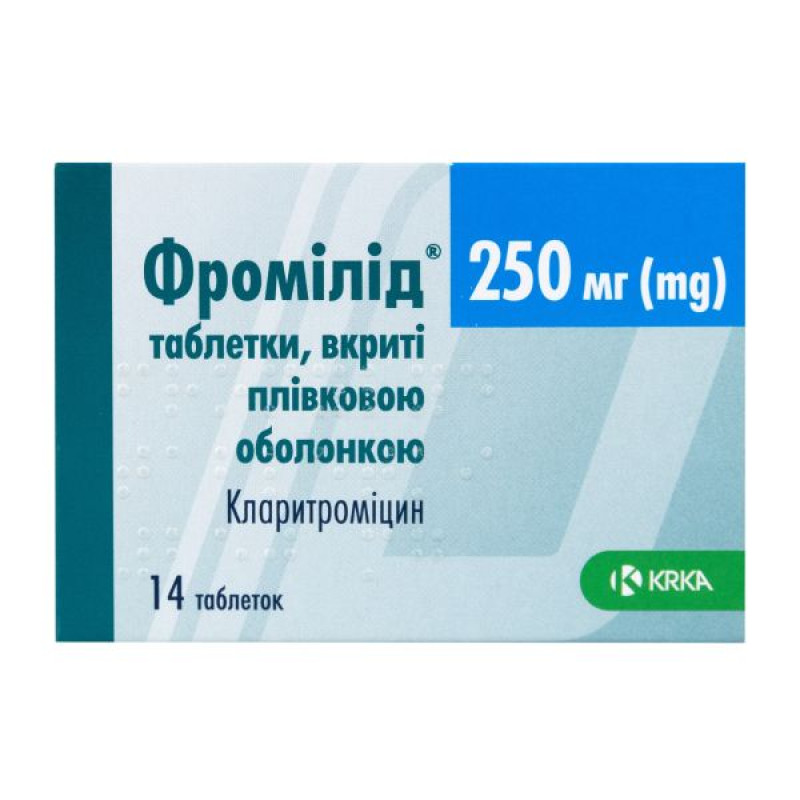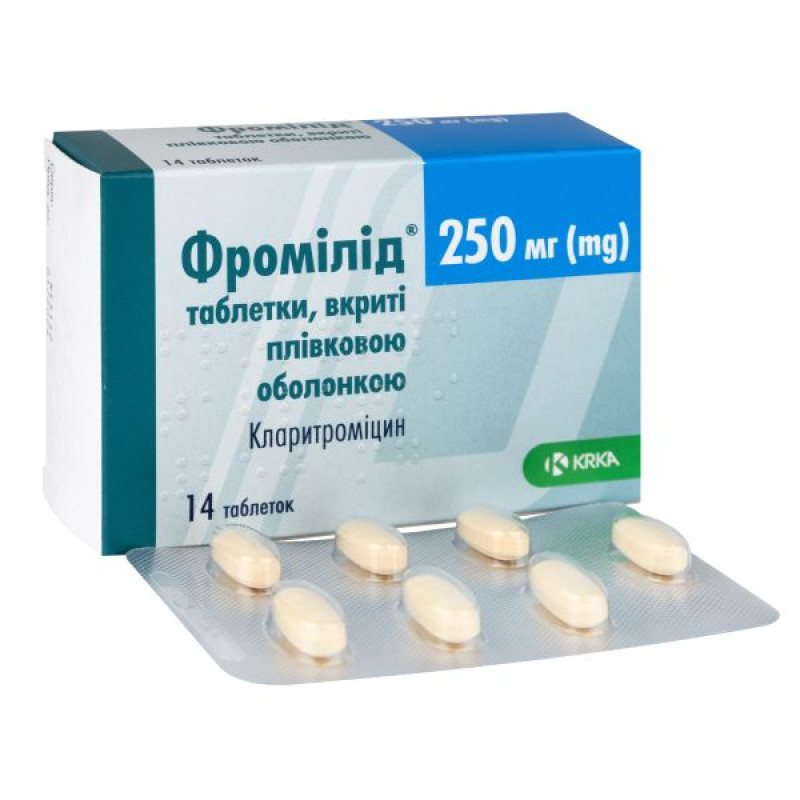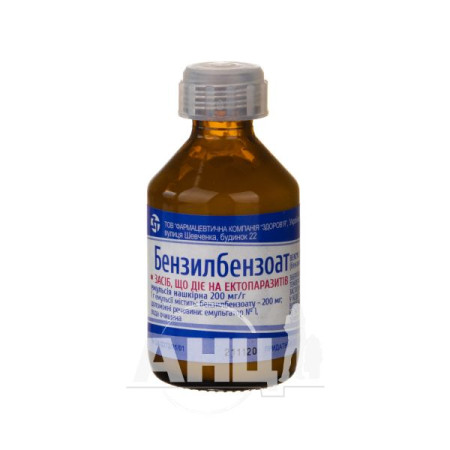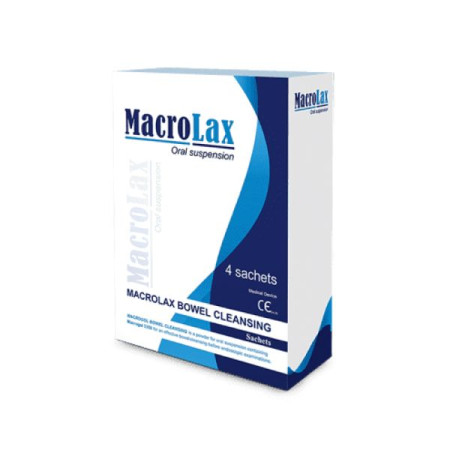Fromilid film-coated tablets 250 mg No. 14
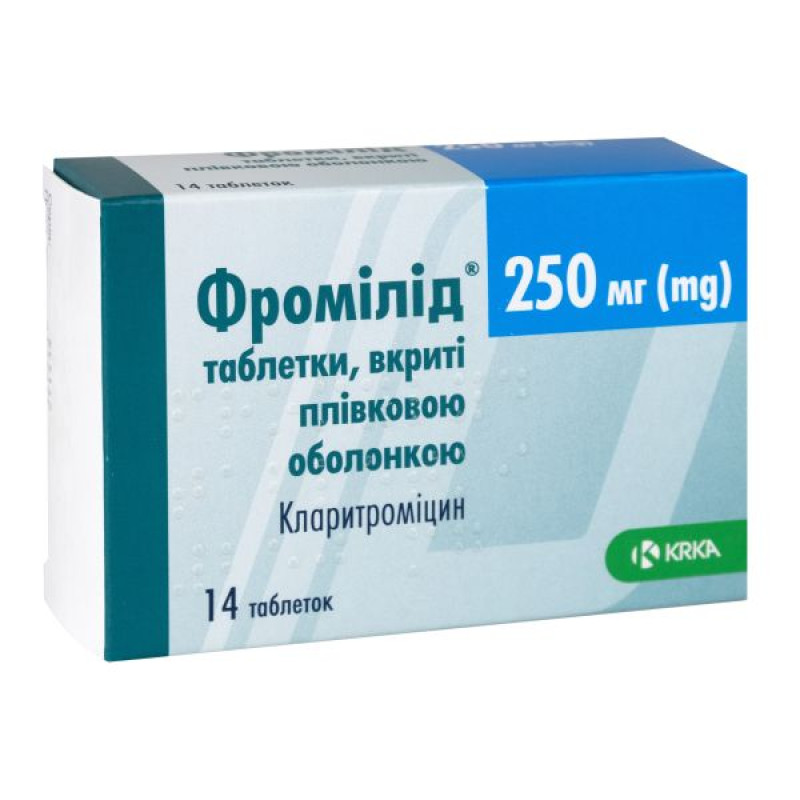
Instructions Fromilid film-coated tablets 250 mg No. 14
Composition
active ingredient: clarithromycin;
1 tablet contains 250 mg or 500 mg of clarithromycin;
excipients: corn starch, microcrystalline cellulose, colloidal anhydrous silicon dioxide, pregelatinized starch, polacrilin potassium, talc, magnesium stearate, hydroxypropylmethylcellulose, propylene glycol, iron oxide yellow dye (E 172), titanium dioxide (E 171).
Dosage form
Film-coated tablets.
Main physicochemical properties: oval convex tablets of slightly brownish-yellow color, film-coated.
Pharmacotherapeutic group
. Antimicrobials for systemic use. Macrolides, lincosamides and streptogramins. Clarithromycin. ATC code J01F A09.
Pharmacological properties
Pharmacodynamics
Clarithromycin is a semi-synthetic macrolide antibiotic that interacts with the 50S ribosomal subunit of bacteria, thus inhibiting protein synthesis.
It mainly has a bacteriostatic, and in some cases also a bactericidal effect (against Streptococcus pyogenes, Streptococcus pneumoniae and Moraxella catarrhal).
The following microorganisms are susceptible to clarithromycin: Mycoplasma pneumoniae, Legionella pheumophila, Chlamydia trachomatis and C. pneumoniae, Ureaplasma urealyticum; Gram-positive microorganisms (streptococci and staphylococci, Listeria monocytogenes, Corynebacterium spp.); Gram-negative microorganisms (Haemophilus influenzae and H. ducreyi, Moraxella catarrhalis, Bordetella pertussis, Neisseria gonorrhoeae and N. meningitidis, Borrelia burgdorferi, Pasteurella multocida, Campylobacter spp. and Helicobacter pylori); some anaerobes (Eubacterium spp., Peptococcus spp., Peptostreptococus spp., Propionobacterium spp., Clostridium perfringens and Bacteroides melaninogenicus); Toxoplasma gondii and all mycobacteria except M. tuberculosis.
Due to the variable structure of human cell ribosomes, macrolides do not bind to the ribosomal units of human cells, which is the reason for the low toxicity of macrolides in humans.
Pharmacokinetics
Clarithromycin is well absorbed from the gastrointestinal tract. Bioavailability is approximately 55% after an oral dose. Food may slow absorption but does not significantly affect the bioavailability of clarithromycin. Approximately 20% of clarithromycin is immediately metabolized to the major metabolite, 14-hydroxyclarithromycin, which has the same biological activity as clarithromycin. In healthy subjects, it reaches serum concentrations proportional to the size of the oral dose. Peak serum concentrations are observed in less than 3 hours. After a single oral dose of 250 mg of clarithromycin, mean concentrations range from 0.62 μg/mL to 0.84 μg/mL; after a single oral dose of 500 mg of clarithromycin, they range from 1.77 μg/mL to 1.89 μg/mL. The corresponding concentrations of 14-hydroxyclarithromycin are 0.4 μg/ml to 0.7 μg/ml after a 250 mg dose and 0.67 μg/ml to 0.8 μg/ml after a 500 mg dose. The area under the concentration-time curve (AUC x time) values are 4 μg/ml x h after a 250 mg dose and 11 μg/ml x h after a 500 mg dose.
Steady-state concentrations are achieved after the fifth dose of 250 mg clarithromycin administered twice daily; the maximum concentration of clarithromycin is 1 μg/mL and 14-hydroxyclarithromycin is 0.6 μg/mL.
Clarithromycin penetrates well into body fluids and tissues, where it reaches concentrations 10 times higher than in plasma. High concentrations are found in the lungs (8.8 mg/kg), tonsils (1.6 mg/kg), nasal mucosa, skin, saliva, alveoli, sputum and in the middle ear. The volume of distribution of clarithromycin in healthy subjects after a single dose of 250 mg and 500 mg is 226-266 l/kg and 2.5 l/kg, respectively. The volume of distribution of 14-hydroxyclarithromycin is 304-309 l. The binding of clarithromycin to serum proteins is weak and reversible.
The half-life of clarithromycin at a dose of 250 mg/12 hours is 3-4 hours and at a dose of 500 mg/12 hours - 5-7 hours.
Metabolism and excretion
Clarithromycin is metabolized in the liver. At least 7 metabolites have been identified. The most important is 14-hydroxyclarithromycin. Clarithromycin is excreted in the urine either as metabolites or unchanged, and to a lesser extent in the feces (4%). Approximately 20% of a 250 mg dose and 30% of a 500 mg dose are excreted unchanged in the urine. 10-15% of the dose is excreted in the urine as 14-hydroxyclarithromycin.
The half-life of clarithromycin at a dose of 250 mg/12 hours is 3-4 hours, and at a dose of 500 mg/12 hours - 5-7 hours.
Effect of age and disease on pharmacokinetics
Children and infants: Studies have shown that the pharmacokinetics of clarithromycin in children at a dose of 7.5 mg/kg body weight twice daily were similar to those in adults.
Elderly patients: There is no need for dose adjustment in elderly patients unless they have severe renal impairment.
Steady-state concentrations of clarithromycin in patients with hepatic impairment do not differ from those in healthy subjects, but concentrations of the 14-hydroxy metabolite are lower.
Indication
Infections caused by microorganisms sensitive to clarithromycin.
Lower respiratory tract infections (bronchitis, acute croupous pneumonia and primary atypical pneumonia). Upper respiratory tract infections, i.e. nasopharynx (tonsillitis, pharyngitis), and paranasal sinus infections. Skin and soft tissue infections (impetigo, folliculitis, erysipeloid, furunculosis, infected wounds). Gout and chronic odontogenic infections. Disseminated or localized mycobacterial infections caused by Mycobacterium avium or Mycobacterium intracellulare. Localized infections caused by Mycobacterium chelonae, Mycobacterium fortuitum or Mycobacterium kansasii. Eradication of H. pylori in patients with duodenal ulcer when suppressing hydrochloric acid secretion (the activity of clarithromycin against H. pylori is higher at neutral pH than at acidic pH).
Contraindication
· Hypersensitivity to clarithromycin or to other macrolide antibiotics or to any of the ingredients of the drug.
Concomitant use with any of the following drugs: astemizole, cisapride, pimozide, terfenadine (as this may lead to prolongation of the QT interval and the development of cardiac arrhythmias, including ventricular tachycardia, ventricular fibrillation and torsades de pointes); ergot alkaloids, e.g. ergotamine, dihydroergotamine (as this may lead to ergotoxicity); HMG-CoA reductase inhibitors (statins) that are largely mobilised by CYP3A4 (lovastatin or simvastatin) due to an increased risk of myopathy, including rhabdomyolysis (see "Special warnings and precautions for use", "Interaction with other medicinal products and other forms of interaction"). Concomitant use of clarithromycin and oral midazolam (see "Special warnings and precautions for use", "Interaction with other medicinal products and other forms of interaction") types of interactions").
Patients with a history of QT prolongation or ventricular cardiac arrhythmias, including torsade de pointes (see "Special warnings and precautions for use", "Interaction with other medicinal products and other types of interactions").
Patients with hypokalemia (risk of QT prolongation).
Severe hepatic insufficiency and concomitant renal insufficiency.
Concomitant use of clarithromycin (and other strong CYP3A4 inhibitors) with colchicine in patients with renal or hepatic insufficiency (see "Special warnings and precautions for use", "Interaction with other medicinal products and other types of interactions").
Concomitant use of clarithromycin with ticagrelor or ranolazine.
Interaction with other medicinal products and other types of interactions
Clarithromycin does not interact with oral contraceptives.
The use of the following drugs is strictly contraindicated due to the possible development of severe interaction effects:
Cisapride, pimozide, astemizole, and terfenadine
Increased serum levels of cisapride have been observed when cisapride is co-administered with clarithromycin, which may result in QT prolongation and arrhythmias including ventricular tachycardia, ventricular fibrillation and torsade de pointes. Similar effects have been observed when pimozide and clarithromycin are co-administered (see Contraindications).
Macrolides have been reported to alter the metabolism of terfenadine, leading to increased serum levels of terfenadine, which have sometimes been associated with cardiac arrhythmias such as QT prolongation, ventricular tachycardia, ventricular fibrillation and torsade de pointes (see Contraindications). In a study of 14 volunteers, concomitant administration of terfenadine and clarithromycin resulted in a 2- to 3-fold increase in the acid metabolite of terfenadine and a prolongation of the QT interval, without any clinically apparent effect. Similar effects have been observed with concomitant administration of astemizole and other macrolides.
Ergotamine/dihydroergotamine
Postmarketing reports indicate that concomitant use of clarithromycin and ergotamine or dihydroergotamine has been associated with the development of signs of acute ergotism, characterized by vasospasm and ischemia of the extremities and other tissues, including the central nervous system. Concomitant administration of clarithromycin and ergot alkaloids is contraindicated (see Contraindications).
HMG-CoA reductase inhibitors (statins)
Caution should be exercised when prescribing clarithromycin concomitantly with statins. If concomitant use of clarithromycin with statins cannot be avoided, the lowest approved dose of the statin is recommended. A statin that is not metabolized by CYP3A (e.g. fluvastatin) may be used. Patients should be monitored for signs and symptoms of myopathy.
Effect of other drugs on the pharmacokinetics of clarithromycin
Medicinal products that are inducers of CYP3A (e.g. rifampicin, phenytoin, carbamazepine, phenobarbital, St. John's wort) may induce the metabolism of clarithromycin. This may lead to subtherapeutic levels of clarithromycin and reduced efficacy. In addition, monitoring of plasma levels of the CYP3A inducer, which may be increased due to inhibition of CYP3A by clarithromycin, may be necessary (see also the Summary of Product Characteristics of the respective CYP3A4 inducer). Concomitant use of rifabutin and clarithromycin has been shown to increase rifabutin levels and decrease clarithromycin serum levels, with a concomitant increase in the risk of uveitis.
The following drugs are known or suspected to affect clarithromycin blood concentrations and may require dose adjustment or alternative therapy.
Efavirenz, nevirapine, rifampicin, rifabutin, and rifapentine
Potent inducers of cytochrome P450 enzymes, such as efavirenz, nevirapine, rifampicin, rifabutin and rifapentine, may accelerate the metabolism of clarithromycin, reducing its plasma concentration but increasing the concentration of 14-OH-clarithromycin, the microbiologically active metabolite. Since the microbiological activity of clarithromycin and 14-OH-clarithromycin is different against different bacteria, the expected therapeutic effect may not be achieved due to the combined use of clarithromycin and inducers of cytochrome P450 enzymes.
Etravirine
Clarithromycin activity was attenuated by etravirine; however, concentrations of the active metabolite 14-OH-clarithromycin were increased. Since 14-OH-clarithromycin has reduced activity against Mycobacterium avium complex (MAC), overall activity against this pathogen may be altered. Therefore, alternative agents to clarithromycin should be considered for the treatment of MAC.
Fluconazole
The steady-state concentrations of the active metabolite 14-OH-clarithromycin were not significantly altered by co-administration with fluconazole. No dose adjustment of clarithromycin is required.
Ritonavir
The use of ritonavir and clarithromycin resulted in significant inhibition of clarithromycin metabolism. Clarithromycin Cmax increased by 31%, Cmin by 182%, and AUC by 77%. Complete inhibition of 14-OH-clarithromycin formation was observed. Due to the large therapeutic window, no dose reduction of clarithromycin is required for patients with normal renal function. Dosage adjustment is required for patients with renal insufficiency: for CLCR 30-60 ml/min, the dose of clarithromycin should be reduced by 50% to the maximum dose of 1 tablet per day; for CLCR < 30 ml/min, the dose should be reduced by 75%. Doses of clarithromycin exceeding 1 g/day should not be used with ritonavir.
Similar dose adjustments should be made for patients with impaired renal function when ritonavir is used as a pharmacokinetic enhancer with other HIV protease inhibitors, including atazanavir and saquinavir.
Effect of clarithromycin on the pharmacokinetics of other drugs.
Antiarrhythmic drugs
There have been postmarketing reports of torsades de pointes associated with concomitant use of clarithromycin with quinidine or disopyramide. ECG monitoring is recommended for early detection of QT prolongation. Serum concentrations of these drugs should be monitored during clarithromycin therapy.
During post-marketing use, there have been reports of hypoglycemia with the simultaneous use of clarithromycin and disopyramide, therefore, monitoring of blood glucose levels is necessary when these agents are used simultaneously.
Oral hypoglycemic agents/insulin
When used concomitantly with certain hypoglycemic agents such as nateglinide and repaglinide, clarithromycin may inhibit the CYP3A enzyme, which may cause hypoglycemia. Close monitoring of glucose levels is recommended.
CYP3A-related interactions
Concomitant use of clarithromycin, a known inhibitor of the CYP3A enzyme, and a drug that is primarily metabolized by CYP3A may result in increased plasma concentrations of the latter, which in turn may increase or prolong its therapeutic effect and the risk of adverse reactions. Caution should be exercised when administering clarithromycin to patients receiving therapy with drugs that are CYP3A substrates, especially if the CYP3A substrate has a narrow therapeutic index (e.g., carbamazepine) and/or is extensively metabolized by this enzyme.
The following drugs or drug classes are known (or suspected) to be metabolized by the same CYP3A isoenzyme: alprazolam, astemizole, carbamazepine, cilostazol, cisapride, cyclosporine, disopyramide, ergot alkaloids, lovastatin, methylprednisolone, midazolam, omeprazole, oral anticoagulants (e.g. warfarin), pimozide, quinidine, rifabutin, sildenafil, simvastatin, tacrolimus, terfenadine, triazolam and vinblastine. A similar mechanism of interaction has been observed with phenytoin, theophylline and valproate, which are metabolized by a different cytochrome P450 isoenzyme.
Omeprazole
The use of clarithromycin in combination with omeprazole in healthy adult volunteers resulted in an increase in the equilibrium concentrations of omeprazole. When using omeprazole alone, the average pH of gastric juice measured over 24 hours was 5.2, when using omeprazole with clarithromycin - 5.7.
Sildenafil, tadalafil and vardenafil
There is a possibility of increased plasma concentrations of phosphodiesterase inhibitors (sildenafil, tadalafil and vardenafil) when co-administered with clarithromycin, which may require a reduction in the dose of phosphodiesterase inhibitors.
Theophylline, carbamazepine
Clinical trial results have shown that there is a small but statistically significant increase in theophylline or carbamazepine plasma concentrations when co-administered with clarithromycin.
Tolterodine
A dose reduction of tolterodine may be necessary when used with clarithromycin.
Triazolebenzodiazepines (e.g. alprazolam, midazolam, triazolam)
When midazolam was administered with clarithromycin tablets (500 mg twice daily), the AUC of midazolam increased 2.7-fold after intravenous administration and 7-fold after oral administration of midazolam. The combined use of oral midazolam and clarithromycin should be avoided. When intravenous midazolam is administered with clarithromycin, the patient's condition should be carefully monitored for timely dose adjustment.
The same precautions should be observed when using other benzodiazepines that are metabolized by CYP3A, including triazolam and alprazolam. For benzodiazepines whose elimination is not dependent on CYP3A (temazepam, nitrazepam, lorazepam), the development of clinically significant interactions with clarithromycin is unlikely.
There have been post-marketing reports of drug interactions and the development of central nervous system adverse events (such as drowsiness and confusion) with the concomitant use of clarithromycin and triazolam. The patient should be monitored for the possibility of increased central nervous system pharmacological effects.
Other types of interactions
Aminoglycosides
Clarithromycin should be used with caution in combination with other ototoxic agents, especially aminoglycosides (
see "Features of use").
Colchicine
Colchicine is a substrate of CYP3A and P-glycoprotein (Pgp). Clarithromycin and other macrolides are known to inhibit CYP3A and Pgp. When clarithromycin and colchicine are coadministered, inhibition of Pgp and CYP3A by clarithromycin may result in increased exposure to colchicine. Patients should be monitored for clinical signs of colchicine toxicity.
Digoxin
In postmarketing experience, increased serum digoxin concentrations have been reported in patients receiving clarithromycin concomitantly with digoxin. Some patients have developed signs of digitalis toxicity, including potentially fatal arrhythmias. Serum digoxin concentrations should be closely monitored in patients receiving clarithromycin concomitantly.
Zidovudine
Concomitant use of clarithromycin immediate-release tablets and zidovudine in HIV-infected patients may result in decreased steady-state serum concentrations of zidovudine. This can be largely avoided by spacing the doses of clarithromycin and zidovudine. No such interaction has been reported with clarithromycin suspension and zidovudine or dideoxynazine in children. Interaction studies with clarithromycin extended-release tablets and zidovudine have not been conducted.
Phenytoin and valproate
There have been spontaneous or published reports of interactions between CYP3A inhibitors, including clarithromycin, and drugs not considered to be metabolized by CYP3A (e.g., phenytoin and valproate). It is recommended that serum levels of these drugs be monitored when co-administered with clarithromycin. Increased serum levels have been reported.
Bidirectional drug interactions
Atazanavir
Calcium channel blockers
Due to the risk of hypotension, caution should be exercised when administering clarithromycin concomitantly with calcium channel blockers metabolized by CYP3A4 (e.g. verapamil, amlodipine, diltiazem). The interaction may result in increased plasma concentrations of both clarithromycin and the calcium channel blocker.
Hypotension, bradyarrhythmias, and lactic acidosis have been observed in patients receiving clarithromycin with verapomil.
Itraconazole
Clarithromycin and itraconazole are substrates and inhibitors of CYP3A, and therefore clarithromycin may increase plasma levels of itraconazole and vice versa. When itraconazole is used concomitantly with clarithromycin, patients should be closely monitored for signs or symptoms of increased or prolonged effects.
Saquinavir
The use of clarithromycin (500 mg twice daily) with saquinavir (soft gelatin capsules 1200 mg three times daily), which are substrates and inhibitors of CYP3A, resulted in an increase in steady-state AUC by 177% and Cmax by 187% compared to the use of saquinavir alone. At the same time, the AUC and Cmax of clarithromycin increased by approximately 40% compared to the use of clarithromycin alone. No dose adjustment is necessary if both drugs are used simultaneously for a limited period of time and in the above doses and dosage forms. The results of a drug interaction study with the use of soft gelatin capsules may not correspond to the effects observed with the use of saquinavir in the form of hard gelatin capsules. The results of a drug interaction study with saquinavir alone may not correspond to the effects observed with saquinavir/ritonavir therapy. When saquinavir is used with ritonavir, the possible effects of ritonavir on clarithromycin should be considered (see above).
Application features
Prolonged or repeated use of antibiotics may result in overgrowth of nonsusceptible bacteria and fungi. If superinfection occurs, clarithromycin should be discontinued and appropriate therapy initiated.
The drug should be used with caution in patients with severe renal insufficiency.
Hepatic dysfunction, including elevated liver enzymes, and hepatocellular and/or cholestatic hepatitis with or without jaundice, have been reported with clarithromycin. These hepatic dysfunctions may be severe and are usually reversible. Fatal hepatic failure has occasionally been reported, and has been associated with serious underlying diseases and/or concomitant medication. Clarithromycin should be discontinued immediately if signs and symptoms of hepatitis such as anorexia, jaundice, dark urine, pruritus, or abdominal pain occur.
Clostridium difficile-associated diarrhea (CDAD) has been reported to range in severity from mild to fatal with nearly all antibacterial agents, including clarithromycin. The possibility of Clostridium difficile-associated diarrhea should be kept in mind in all patients presenting with diarrhea following antibiotic therapy. In addition, a careful history should be taken, as Clostridium difficile-associated diarrhea has been reported up to 2 months after antibiotic therapy.
Clarithromycin is primarily eliminated by the liver. Caution should be exercised when administering the drug to patients with impaired hepatic function, as well as moderate or severe renal impairment.
Colchicine
Colchicine toxicity (including fatal outcomes) has been reported with concomitant use of clarithromycin and colchicine, particularly in elderly patients, including those with renal impairment (see Interactions with other medicinal products and other forms of interaction). Concomitant use of clarithromycin and colchicine is contraindicated (see Contraindications).
Caution should be exercised when clarithromycin is administered concomitantly with triazolebenzodiazepines, e.g. triazolam, intravenous midazolam (see Interactions with other medicinal products and other forms of interaction).
Clarithromycin should be used with caution in combination with other ototoxic agents, especially aminoglycosides. Vestibular and auditory function should be monitored during and after treatment.
Due to the risk of QT prolongation, clarithromycin should be used with caution in patients with ischemic heart disease, severe heart failure, hypomagnesemia, bradycardia (< 50 beats/min) or when used concomitantly with drugs associated with QT prolongation (see "
Interaction with other medicinal products and other forms of interaction"). Clarithromycin should not be used in patients with congenital or history of QT prolongation or with a history of ventricular cardiac arrhythmia (see "Contraindications").
Pneumonia
Mild to moderate skin and soft tissue infections
These infections are most commonly caused by Staphylococcus aureus and Streptococcus pyogenes, both of which may be resistant to macrolides. Susceptibility testing is therefore important. In cases where beta-lactam antibiotics are not suitable (e.g. allergy), other antibiotics such as clindamycin may be used as first-line agents. Macrolides currently have a role only in the treatment of certain skin and soft tissue infections, such as: infections caused by Corynebacterium minutissimum (erythrasma), acne vulgaris, erysipelas; and in situations where penicillin treatment is not appropriate.
In the event of severe acute hypersensitivity reactions such as anaphylaxis, Stevens-Johnson syndrome, toxic epidermal necrolysis, DRESS, Henoch-Schonlein-Schönlein disease, clarithromycin therapy should be discontinued immediately and appropriate treatment should be initiated immediately.
Clarithromycin should be used with caution when co-administered with inducers of the cytochrome CYP3A4 enzyme (see Interactions with other medicinal products and other forms of interaction).
Attention should be paid to the possibility of cross-resistance between clarithromycin and other macrolides, as well as lincomycin and clindamycin.
HMG-CoA reductase inhibitors (statins)
The combined use of clarithromycin with lovastatin or simvastatin is contraindicated (see "Contraindications"). Caution should be exercised when clarithromycin is administered concomitantly with other statins. Rhabdomyolysis has been reported in patients receiving concomitant clarithromycin and statins. Patients should be monitored for signs and symptoms of myopathy. If concomitant use of clarithromycin with statins cannot be avoided, it is recommended that the lowest registered dose of the statin be used. A statin that is not dependent on CYP3A metabolism (e.g. fluvastatin) may be used (see "Interaction with other medicinal products and other forms of interaction").
Oral hypoglycemic agents/insulin
Concomitant use of clarithromycin and oral hypoglycemic agents (e.g. sulfonylureas) and/or insulin may cause severe hypoglycemia. Close monitoring of glucose levels is recommended.
Oral anticoagulants
Concomitant use of clarithromycin with warfarin carries a risk of serious bleeding, significant increases in INR (international normalized ratio) and prothrombin time. While patients are receiving clarithromycin and oral anticoagulants, frequent monitoring of INR and prothrombin time is necessary.
Use during pregnancy or breastfeeding
Pregnancy. The safety of clarithromycin during pregnancy and lactation has not been established. Clarithromycin should not be used during pregnancy without careful benefit/risk assessment.
Breastfeeding period.
Clarithromycin is excreted in breast milk. Breastfeeding should be discontinued during treatment with the drug.
Ability to influence reaction speed when driving vehicles or other mechanisms
There are no data on the effects. However, it should be taken into account the possible occurrence of adverse reactions from the nervous system, such as convulsions, dizziness, vertigo, hallucinations, confusion, disorientation, etc., which may affect the speed of psychomotor reactions. consciousness.
Method of administration and doses
Take orally, without chewing, with a small amount of water, regardless of meals.
The recommended dose of clarithromycin for adults and children aged 12 years and over is 250 mg twice daily, with more severe infections the dose may be increased to 500 mg twice daily. The usual duration of treatment depends on the severity of the infection and is 6 to 14 days.
Treatment of odontogenic infections.
Apply 250 mg 2 times a day for 5 days.
Use for patients with mycobacterial infection.
The initial dose for adults is 500 mg twice daily. If there is no improvement in clinical signs or bacteriological parameters within 3-4 weeks of treatment, the dose of clarithromycin may be increased to 1000 mg twice daily.
Treatment of disseminated infections caused by Mycobacterium avium complex in AIDS patients should be continued for as long as the clinical and microbiological efficacy of the drug is medically proven. Clarithromycin should be used in combination with other antimicrobial drugs.
The duration of treatment for other non-tuberculous mycobacterial infections is determined by the doctor individually.
Eradication of H. pylori in patients with duodenal ulcer (adults):
Triple therapy (7-10 days):
500 mg of clarithromycin 2 times a day simultaneously with amoxicillin 1000 mg 2 times a day and omeprazole 20 mg 1 time a day for 7-10 days.
Triple therapy (10 days):
500 mg of clarithromycin twice daily, 30 mg of lansoprazole twice daily, and 1000 mg of amoxicillin twice daily for 10 days.
Dual therapy (14 days):
500 mg of clarithromycin 3 times a day together with 40 mg of omeprazole once a day for 14 days, then 20 mg or 40 mg of omeprazole once a day for the next 14 days.
Clarithromycin 500 mg 3 times daily with lansoprazole 60 mg once daily for 14 days. Further acid suppression may be required to reduce ulcer symptoms.
Clarithromycin is also used in the following therapeutic regimens:
Clarithromycin + tinidazole and omeprazole or lansoprazole;
clarithromycin + metronidazole and omeprazole or lansoprazole;
clarithromycin + tetracycline, bismuth subsalicylate or ranitidine;
clarithromycin + amoxicillin and lansoprazole;
clarithromycin + ranitidine bismuth citrate.
Use for the elderly: as for adults.
Use in patients with renal impairment: Usually no dose adjustment is necessary, except in patients with severe renal impairment (creatinine clearance < 30 ml/min). If dose adjustment is necessary, the daily dose should be halved, i.e. 250 mg once daily or 250 mg twice daily for more severe infections. In such patients, the duration of treatment should not exceed 14 days.
Children
Children under 12 years of age should use the drug in suspension form.
Overdose
Symptoms: vomiting, abdominal pain, headache and dizziness. One patient with a history of bipolar disorder reported mental status changes, paranoid behavior, hypokalemia and hypoxemia after taking 8 g of clarithromycin.
Treatment: gastric lavage and symptomatic therapy. As with other macrolides, hemodialysis is unlikely to significantly affect the serum levels of clarithromycin.
Adverse reactions
Clarithromycin is usually well tolerated.
The most common and common adverse reactions in adults and children treated with clarithromycin are abdominal pain, diarrhea, nausea, vomiting, and taste perversion. These adverse reactions are usually mild and consistent with the known safety profile of macrolide antibiotics. There is no significant difference in the frequency of these adverse reactions between groups of patients with or without mycobacterial infections.
Side effects that may occur during clarithromycin therapy are classified by organ system:
Infections and infestations: cellulitis1, oral candidiasis, gastroenteritis2, infection3, vaginal infection; pseudomembranous colitis, erysipelas, erythrasma.
Blood and lymphatic system disorders: leukopenia, neutropenia4, thrombocythemia3, eosinophilia4, agranulocytosis, thrombocytopenia.
Immune system disorders: anaphylactoid reactions1, hypersensitivity, anaphylactic reactions, angioedema.
Metabolism and nutrition disorders: anorexia, decreased appetite, hypoglycemia5.
Psychiatric: insomnia, anxiety, nervousness3, screaming3, psychosis, confusion, depersonalization, depression, disorientation, hallucinations, nightmares, mania.
Central nervous system: dysgeusia (taste disturbance), headache, taste perversion, loss of consciousness1, dyskinesia1, dizziness, drowsiness, tremor, convulsions, ageusia (loss of taste), parosmia, anosmia, paresthesia.
From the side of the organs of hearing and labyrinth: dizziness, hearing impairment, tinnitus, hearing loss.
Cardiac disorders: cardiac arrest1, atrial fibrillation1, QT prolongation, extrasystoles1, palpitations, torsades de pointes, ventricular tachycardia.
Vascular: vasodilation1, hemorrhage.
Respiratory, thoracic and mediastinal disorders: asthma1, epistaxis2, pulmonary embolism1.
From the digestive system: diarrhea, vomiting, dyspepsia, nausea, abdominal pain, esophagitis1, gastroesophageal reflux disease2, gastritis, proctalgia2, stomatitis, glossitis, abdominal distension4, constipation, dry mouth, eructation, flatulence, goiter
There are no reviews for this product.
There are no reviews for this product, be the first to leave your review.
No questions about this product, be the first and ask your question.




